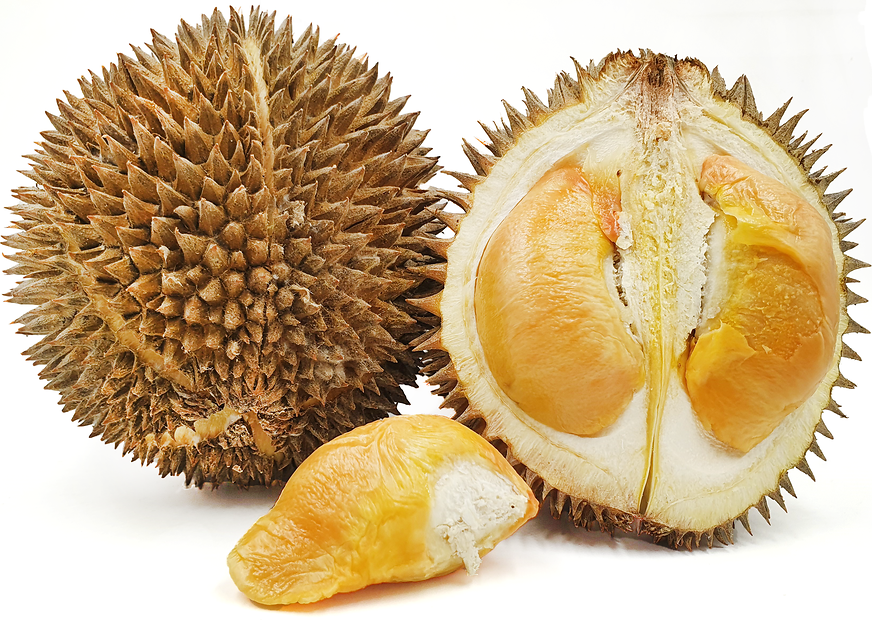


Pelangi Durian
Estimated Inventory, lb : 0
Description/Taste
Pelangi durians are large fruits, averaging 20 to 30 centimeters in length, and have an oval to oblong shape, covered in broad, stiff spikes. The tough, sharp exterior ranges in color from green, yellow, to brown with a few vertical seams, and underneath the pointed surface, the thick rind has a fibrous consistency. The rind can be sliced or torn open to reveal multi-lobed flesh, surrounded by a white to cream-colored, spongy pith. The flesh widely ranges in color, depending on the individual tree, and can be found in distinct marbling and striping of white, pale yellow, pink, orange, to red hues. The flesh is also thick, dense, slightly sticky, and waxy with a creamy consistency, encasing flat, medium-sized seeds. Pelangi durians have a sweet, pungent flavor with a mild tannic taste.
Seasons/Availability
Pelangi durians are available in the summer.
Current Facts
Pelangi durians, botanically a part of the Durio genus, are a hybrid variety belonging to the Malvaceae family. The name Pelangi translates from Indonesian to mean “rainbow,” which is a descriptor used to highlight the unique flesh coloring. Pelangi durians were created from natural crosses between three distinct durian species durio zibethinus, durio gravoelens, and durio kutejensis. The hybrid fruits are one of the only durians developed from more than two species, and this complex crossing creates brightly colored variegated flesh. Beyond their rarity, Pelangi durians are also being trialed as a new Indonesian commercial variety in hopes of competing with dominant durian cultivars stemming from Malaysia and Thailand. Pelangi durians can be grown in a wide range of climates and have an extended shelf life, staying fresh for 6 to 7 days compared to the average shelf life of 2 to 3 days. The trees are also very productive, fruiting twice a year, allowing for a harvest of up to 800 fruits.
Nutritional Value
Pelangi durians are an excellent source of anthocyanins, which are the red pigments found in the flesh that protect the body against free radical damage. The fruits are also a good source of beta-carotene and vitamin C, an antioxidant that can reduce inflammation, improve complexion, and strengthen the immune system. In addition to vitamins, Pelangi durians contain minerals, including copper, iron, calcium, and potassium, contributing to healthy organ, bones, and joint functioning.
Applications
Pelangi durians are primarily consumed fresh, out-of-hand, as the fruits are favored for their rarity, and the thick, uniquely colored flesh and sweet flavor is showcased when raw. The multi-colored flesh can also be blended into juices, smoothies, and fruit drinks, or it can be sliced and served over sticky rice. In addition to fresh applications, Pelangi durians can be blended with sugar into ice cream or cooked into a paste-like filling for pastries, desserts, and other baked goods. They can also be incorporated into curries, fried rice, and condiments. Pelangi durians pair well with coconut milk, passion fruit, mint, lemongrass, vanilla, dark chocolate, spices such as cinnamon, cloves, and cardamom, tamarind, and peanuts. Whole, unopened Pelangi durians will keep for one week when stored in a cool location. Once sliced, the flesh is best consumed immediately for optimal flavor and can be stored for an additional 2 to 3 days in the refrigerator.
Ethnic/Cultural Info
Pelangi durians are one of the most popular attractions at the Banyuwangi Durian Festival. The annual fruit celebration draws thousands of international visitors and is held in the main streets around the central park of the Songgon District, a district containing over four thousand durian trees planted throughout fields, home gardens, and farms. The festival date changes each year, depending on the durian season, and the weekend event features vendor stalls selling food, fresh fruits, and retail goods. Pelangi durians are harvested fresh from the local trees and are sold at the event as one of the specialty fruits. Many visitors attend the festival just to try the rainbow-fleshed durian, and the fruits sell out quickly. Along the main roadways to the festival, local farms also construct durian stands to sell additional Pelangi durians to passing motorists.
Geography/History
Pelangi durians are native to Manokwari, located in the eastern province of Papua, Indonesia. The hybrid fruits have been naturally growing since ancient times, with some trees being over one hundred years in age. Pelangi durians were first officially discovered, documented, and named by scientist and researcher Karim Aristides. Today Pelangi durians are cultivated by a few farms throughout Indonesia, and when in season, the fruits are sold through local markets as specialty items. Pelangi durians are also being grown at the Indonesian Tropical Fruit Research Institute in an effort to study the variety and develop for commercial cultivation.
Recipe Ideas
Recipes that include Pelangi Durian. One
| Nyonya Cooking |
|
Durian Crepe |
| Sher Bakes |
|
Durian Mousse Dessert |
| Thai Food Rocks |
|
Durian Massaman Curry |
| Kuali |
|
Durian Souffles |
| The Hong Kong Cookery |
|
Durian Ice Cream |




